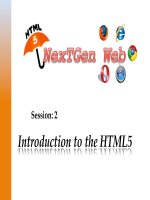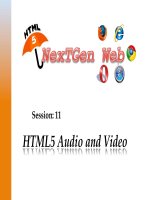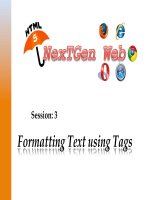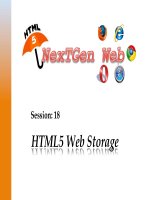HTML5 XP session 05 tủ tài liệu bách khoa
Bạn đang xem bản rút gọn của tài liệu. Xem và tải ngay bản đầy đủ của tài liệu tại đây (14.74 MB, 35 trang )
Session: 5
Introduction to CSS3
the
new
func,ons
of
CSS3
Iden,fy
Explain
the
different
types
of
selectors
nested
tags
Explain
Define
Classes
and
IDs
for
applying
styles
Explain
the
process
to
apply
styles
to
hyperlink
©
Aptech
Ltd.
Introduc,on
to
CSS3
/
Session
5
2
Cascading Style Sheet (CSS) is a style sheet language.
It informs the browser how to present a document.
It uses a markup language for describing the presentation semantics of a document.
It defines how HTML elements are to be displayed.
©
Aptech
Ltd.
Introduc,on
to
CSS3
/
Session
5
3
Used for adding style such as fonts, colors, and spacing to Web documents.
Has multiple levels and profiles.
Updates each level of CSS from the earlier version, by adding new features.
Denotes version as CSS1, CSS2, CSS3, and CSS4, where the numbers are different for
each version or level.
Is divided into multiple documents called “modules” and each of these modules have
new capabilities or extends the features present in CSS2.
Started drafting of CSS3 when publication of the original CSS2 recommendation was
released.
©
Aptech
Ltd.
Introduc,on
to
CSS3
/
Session
5
4
CSS3
is
available
as
modules
and
is
s,ll
evolving,
there
are
many
modules
As
having
different
stability
and
status.
Only
three
modules
are
released
as
recommenda,ons
and
they
are
as
follows:
CSS Color Level 3
CSS Namespaces
Selectors Level 3
Modules
that
are
stable
and
in
recommenda,on
stage
are
as
follows:
Media Queries
CSS Style Attributes
©
Aptech
Ltd.
Introduc,on
to
CSS3
/
Session
5
5
Modules
that
are
in
tes,ng
phase
and
in
recommenda,on
stage
are
as
follows:
CSS Backgrounds and Borders Level 3
CSS Image Values and Replaced Content Level 3
CSS Marquee
CSS Multi-column Layout
CSS Speech
CSS Mobile Profile 2.0
CSS TV Profile 1.0
Modules
that
are
in
refining
phase
and
in
working
draN
stage
are
as
follows:
CSS Transforms
CSS Transitions
CSS Values and Units Level 3
CSS Print Profile
©
Aptech
Ltd.
Introduc,on
to
CSS3
/
Session
5
6
that
are
in
revising
phase
and
in
working
draN
and
recommenda,on
Modules
stage
are
as
follows:
CSS Animations
CSS Flexible Box Layout
CSS Fonts Level 3
CSS Paged Media Level 3
CSS Text Level 3
CSS Basic User Interface Level 3
CSS Writing Modes Level 3
Some
of
the
following
modules
are
in
exploring
phase
and
in
working
draN
stage:
CSS Cascading and Inheritance Level 3
CSS Conditional Rules Level 3
CSS Grid Layout
CSS Line Grid
©
Aptech
Ltd.
Introduc,on
to
CSS3
/
Session
5
7
Modules
that
are
in
rewri,ng
phase
and
in
working
draN
stage
are
as
follows:
CSS Line Layout Level 3
CSS Ruby
CSS Syntax Level 3
Modules
that
are
in
abandoned
phase
and
in
working
draN
stage
are
as
follows:
Behavioral Extensions to CSS
CSS Hyperlink Presentation
©
Aptech
Ltd.
Introduc,on
to
CSS3
/
Session
5
8
Syntax of CSS consists of three parts namely, selector, property, and value.
Selector is an HTML element for which you want to specify the style or the formatting
instruction.
Property of a selected element is a CSS property that specifies the type of the style to be
applied to the selector.
Value refers to the value of the CSS property and a CSS property can have multiple
values.
Property and the value for a selector are separated with a colon (:).
They are enclosed within the curly brackets ({}) that is known as the declaration block.
©
Aptech
Ltd.
Introduc,on
to
CSS3
/
Session
5
9
Various
combina,ons
available
to
specify
rules
for
HTML
elements
are
as
follows:
You can specify multiple property-value pairs for a selector, which are separated by a
semicolon (;) within the declaration block.
You can specify multiple selectors for a single property by grouping the selectors. To
group the selectors, the selectors are separated by commas followed by a declaration
block of properties and values.
You can specify properties for multiple selectors. Here, the comma-separated selectors
are followed with multiple property-value pairs.
©
Aptech
Ltd.
Introduc,on
to
CSS3
/
Session
5
10
CSS uses various units of measurements for specifying size of the font, width, and
height of margins, and so on.
These units measure the horizontal and vertical length of the content.
CSS supports two types of length measurement units namely, relative and absolute.
©
Aptech
Ltd.
Introduc,on
to
CSS3
/
Session
5
11
Relative length specifies the length units related to other length property that are
calculated in comparison to a current value.
Following
table
lists
some
of
the
rela,ve
length
units.
Relative Length
Description
em
Specifies the font size (height) of a particular font. The em unit is
relative to the value of the font-size property of the selector.
ex
Specifies the ‘x-height’ of a particular font. The ‘x-height’ value is
approximately half the font size or the height of the lowercase letter
‘x’.
px
Specifies the size in pixels, which is relative to the screen of the
device.
©
Aptech
Ltd.
Introduc,on
to
CSS3
/
Session
5
12
Absolute lengths are specified when the Web page designer is aware of the physical
properties of the output device and are specific and fixed values.
Following
table
lists
some
of
the
absolute
length
units.
Relative Length
Description
in
Specifies the size in inches, where 1 inch = 2.54 centimeters.
cm
Specifies the size in centimeters’
mm
Specifies the size in millimeters
pt
pc
©
Aptech
Ltd.
Specifies the size in points, where 1 point = 1/72th of an inch
Specifies the size in picas, where 1 pica = 12 points
Introduc,on
to
CSS3
/
Session
5
13
Percentage allows specifying the length of the content, which is relative to another
value.
Shows
the
use
of
percentage
in
defining
the
style.
©
Aptech
Ltd.
Introduc,on
to
CSS3
/
Session
5
14
Three types of style sheets namely, inline, internal or embedded, and external style
sheets.
An inline style sheet uses the style attribute within an HTML element to specify the style
for HTML elements.
An internal style sheet is also included within the HTML document and is defined using
the style element.
©
Aptech
Ltd.
Introduc,on
to
CSS3
/
Session
5
15
Type attribute of the
style element
specifies the content
type, which is text/css
Placed inside the
<head> section of a
particular Web page
source code
Internal
Styles
Style rules appear in
a declaration block
for each HTML
element under the
style element
Styles can be re-used in
the same Web page in
which they are placed
©
Aptech
Ltd.
Introduc,on
to
CSS3
/
Session
5
16
The
Code
Snippet
demonstrates
how
to
specify
internal
style.
<head>
<meta charset=“utf-8”>
<title>Sample HTML5 Structure</title>
<style>
h1, h2 {
margin:0px;
font-size:1.5em;
}
footer{
background-color:#999;
text-align:center;
}
</style>
</head>
©
Aptech
Ltd.
Introduc,on
to
CSS3
/
Session
5
17
Are placed directly
inside an HTML
element
Inline
Styles
Cannot be reused at
any point of time in a
Web page
Web designer cannot
use the style builder to
create an inline style
The
Code
Snippet
demonstrates
the
use
of
inline
style.
©
Aptech
Ltd.
Introduc,on
to
CSS3
/
Session
5
18
External CSS is
defined in a
separate file and is
saved with the .css
extension
External
Style Sheet
External CSS are
widely used to provide
a consistent look across
the Web pages of a
Web site
Provides the benefit of
reusability by
implementing common
style rules for multiple
HTML pages
The
Code
Snippet
demonstrates
the
use
of
external
CSS.
BODY {
background-color: gray;
font-family: arial;
font-style: italic;
}
©
Aptech
Ltd.
Introduc,on
to
CSS3
/
Session
5
19
Code
Snippet
shows
an
example
of
HTML
code
using
an
external
CSS
style
sheet
demonstrated
earlier.
<!DOCTYPE html>
<html>
<head>
<LINK rel=“stylesheet” type=“text/css” href=“body.css”/>
<title>Webex e-Server</title>
</head>
<body>
This is the fastest web server..!!
</body>
</html>
©
Aptech
Ltd.
Introduc,on
to
CSS3
/
Session
5
20
Selectors refer to the HTML elements with the styles that the users want to apply to
them.
The four different types of CSS selectors are as follows:
Universal selector
Type selector
Selectors
ID selector
Class selector
©
Aptech
Ltd.
Introduc,on
to
CSS3
/
Session
5
21
Styles are specified only
once for an HTML element
and are applied to all the
occurrences of that
elements
Specifies the element
name along with the
styles to be applied to
that element
Results in application of
the specified styles to all
the occurrence of that
element in a Web page
©
Aptech
Ltd.
Introduc,on
to
CSS3
/
Session
5
22
Class selector starts with a
period followed by the
value of the class attribute
Matches elements,
whose class attribute is
set in an HTML page
Applies styles to the
content of all those
elements having the same
class attribute
©
Aptech
Ltd.
Introduc,on
to
CSS3
/
Session
5
23
ID selector starts with the
hash symbol (#) followed
by the id attribute’s value
and the declaration block
Matches an element
whose id attribute is
set in an HTML page
Applies styles to the
content of all those
elements
©
Aptech
Ltd.
Introduc,on
to
CSS3
/
Session
5
24
Represented by an
asterisk (*) sign
Can be applied to all
elements in the
document
Applies the specified styles
to the content of all the
elements
©
Aptech
Ltd.
Introduc,on
to
CSS3
/
Session
5
25









